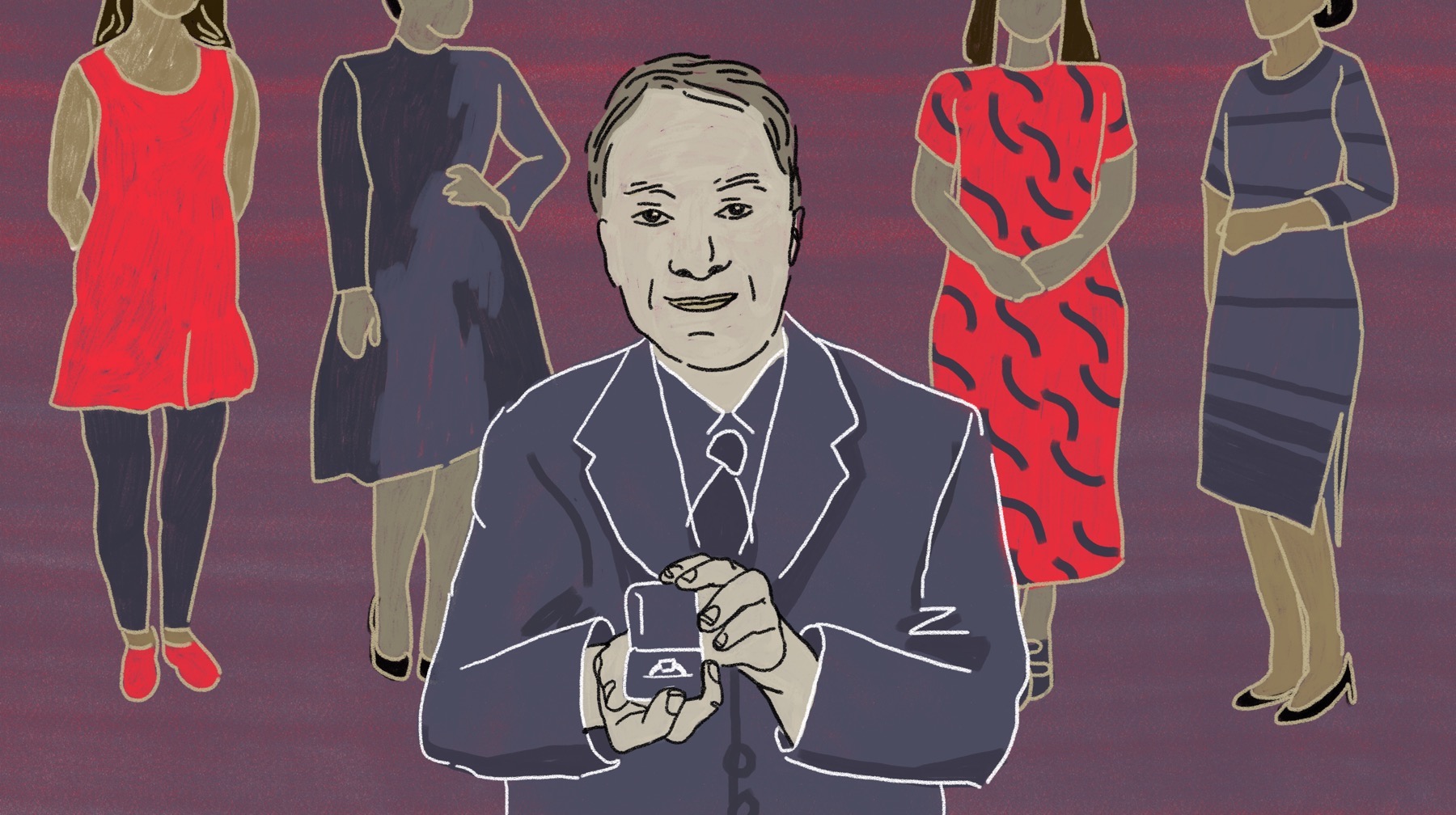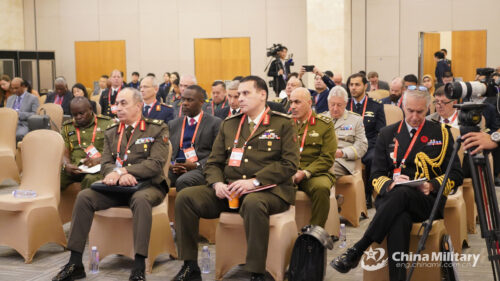‘This isn’t a sex tour’: Inside China’s cross-cultural bride-finding industry

The American men paying for a lightning cure for loneliness — and the Chinese women who welcome them.
Illustration by Anna Vignet

On a regular ol’ spring evening, the 12th floor of the Shenzhen Century Plaza, decked out with white tablecloths and free-flow fruit juice, hosted the equivalent of a spinster fire sale: 200 “highly motivated” Chinese women of varying ages and attractiveness, wearing tight-fitting dresses and name badges announcing “Shirley” or “Ting Ting,” milled about with purpose.
The pressure to find a mate is unusually high in China, where women are still considered “leftover” if they haven’t acquired a homeowner before they’re 27, and 30-year-old unmarried models are practically a distressed asset. So the scene at the Shenzhen Plaza dining room that evening was not unusual — there’s probably an awkward event going on right now, somewhere in Henan or Shanxi — except for one curious aspect:
There were only 12 men, all of them American (and white).
What sounds like a yellow fever-dream is a regular date in the diary of A Foreign Affair, “the largest, most respected International Introduction and Singles Tour Company in the industry… specializing in introducing couples on a global basis,” according to its website, which resembles a ’90s throwback in comfortable pants, an old-fashioned eyesore radiating the kind of HTML that middle-aged Midwestern divorcees may find reassuring.
But if it’s a bride you want, China is certainly open for business, with its marriage markets and proliferation of hook-up apps, matchmakers, and dating gurus. Especially now, “there’s an appetite in China” for cross-cultural relationships among educated urbanites, according to Roseann Lake, author of Leftover in China: The Women Shaping the World’s Next Superpower. Women with 素质 sùzhì — a label that implies quality and sophistication, an ingredient surprisingly lacking on the serious matchmaking scene — are “looking for more egalitarian partnerships,” Lake explained, “and [some] will almost exclusively date foreign men right up until their 30s.” Chinese men simply haven’t kept pace.
“They think that just because they bring money home, that’s enough,” scoffed Careful, the Shenzhen manager of A Foreign Affair, who brings a decade of experience to her endless search for “good looking, sincere, faithful women — not gold diggers — under 40” to introduce at events like the Century Plaza extravaganza. These women are looking, she says, for something, or someone, they cannot find at home.
As a sign outside her office declares, “The Early Bird Catches the Worm,” the word “worm” overlaid with “wife.” Careful deals with a lot of worms, though not so many early birds. Her roster of highly motivated, attractive women, recruited on the street and through word of mouth, can be divided mainly into xiaoluoli (“little princesses”) and zhongnianshaonü (“middle-aged maids”). But the men are invariably older, often resembling the faded Polaroids found in expat bars. Having exhausted all other options, they arrive on the mail-order scene to be greeted like returning lords: “Young beautiful Chinese women are just waiting to meet you!”

Most cross-cultural hookup firms — or mail-order bride companies, as they’re commonly (or anachronistically, depending on who you ask) known — are hawking different versions of the same cure for the centuries-old malady of loneliness. “Mail-order brides are often in such desperate economic conditions,” Beverly Encarguez Perez observed in her 2003 thesis Woman Warrior Meets Mail-Order Bride, that companies “lure them with romanticized images of the dashing First World knight rescuing them from their miserable Third World existence.”
While online dating has shaken off its shameful connotations, the “mail-order” business retains the aura of a punchline foretold, as unrealistic fantasies frequently crumple before the cultural and generational divides. As Perez writes: “All too often, the fairy tale sours as the euphoria of the love affair wears off and the bride sees her husband as he really is: A balding, middle-aged, blue-collar worker with a penchant for beer.” Or the other shoe drops, as “the groom realizes that his bride is not the subservient Asian sex goddess he expected her to be.”
This was a cliché even in Renaissance Europe, whose aristocracy would often agree to nuptials based on little more than a courtly portraiture, most famously in the case of Henry VII. The Tudor king agreed to marry Anne of Cleves on the promise of a Holbein, but failed four times to consummate their union, calling her a “Flanders Mare” and grousing he could “see nothing in this woman as men report of her.” If Anne was the original mail-order bride, Henry was the classic client — a drunk and disgruntled divorcé.
I’d had some indirect experience of the seedier side of “cross-cultural relationship” hunting, thanks to a Polish friend who rented her dingy flat in London by posing as prospective brides for a messaging service targeting lonely Americans. Whether they were romantics or predators didn’t matter: they were all desperate and deluded enough to pay for every message they exchanged with Maja’s range of fictional avatars, even while pleading to take the “relationship” offline.
In Beijing, my roommate paid for much of her tuition by translating at a Chinese matchmaking site. These women were real, and Xiaolin acted as go-between for dozens of international lonelyhearts, all scribbling mutually incomprehensible missives to each other over the internet for Xiaolin to translate. Rarely was much thought given to the poor souls shelling out nightly for this. One evening, Xiaolin translated three different proposals from a man in Minnesota (perhaps this was just a symptom of living in Minnesota). “They’ve all said yes,” Xiaolin reported the next day. “I hope he’s going to buy three rings, at least.”
The International Marriage Broker Act, introduced in 2005 to combat human trafficking, has curbed many of the industry’s worst practices, or at least shamed it into paying lip service to concepts like feminism (one site that previously gloated “there is no such thing as a divorce law in the Philippines” now extols the country’s “positive, confident and outgoing ladies” and their “good business skills”). “It’s maybe not the gold standard of romantic relationships that we idealize,” argued Lake, “but these [women] aren’t naive country bumpkins. If something like this brings them closer to having the life they’d like for themselves, who are we to judge?”
Indeed, whatever one’s misgivings, A Foreign Affair — which is headquartered in Phoenix — at least offers a verifiable, IRL version of practices that would be far shadier elsewhere. When the company came to China in 2007, it offered its services to women for free; local firms had been charging women up to $5,000 to sign up and attend their matchmaking events. “We use the ‘nightclub model,’” Kenneth Agee, the company’s co-founder and genial host of the Shenzhen mixer, explained. “Bring the ladies in, the guys will come.” This was necessary when A Foreign Affair was starting out in countries like Ukraine, Colombia, and the Philippines, where “the economics prohibit the girls from paying,” but it works just as well in China. Otherwise, “We’d just be stopping more attractive, qualified women from joining,” Agee said.
Interestingly, though, eliminating the cost created a different problem: “Women didn’t trust us,” Careful explained. It took a few years for the Chinese to accept that the operation was legitimate — free? It must surely be some scam or scheme! — particularly as women with high suzhi are always charged more, because there are more. (According to one analysis, a client with high suzhi is ideally 25 to 30, living in a first-tier city, like Shenzhen, with at least a bachelor’s degree and monthly income of around $1,000.)
Careful can, at least, reassure her clients that everyone is vetted to make sure they’re not criminals or, worse, married, and that the men they meet will be sincere or, at the very least, as motivated as they are. To conduct a Foreign Affair, after all, requires a U.S. passport, at least $2,195 (the current cost of a week’s trip), and, ideally, a couple of good suits (optional, as I would find out). “This isn’t a sex tour,” Agee pointed out. “This would be way too expensive for those looking for a sex tour.”

Although the men of A Foreign Affair can pay to exchange messages, translate phone calls, and set up dates in advance, the highlight of the $2,000-trip are the two socials, held on consecutive evenings and offering a guarantee to meet at least some strangers of the opposite sex. The set-up — a stodgy buffet, warm drinks, no music — seemed tailored toward the more timid tastes of the local clientele, while lacking the entertainment that Chinese prefer to break the ice (the Russian socials, meanwhile, offer free-flow Champagne in what looks like a banging nightclub).
I’d heard of thunderstruck men proposing on the first night, but whether any rings had been pre-purchased for the Shenzhen Century Plaza event, it was hard to say. But what was apparent was that those who’d traveled the least distance were making the bigger effort: many steadfastly glam women donned qipao, the Qing-era gown and Orientalist stand-by that remains China’s most enduring contribution to fashion (apologies, Hanfu robing).
Jinrong, in her 20s, turned up early and alone, wearing a pink one, so I briefly joined her, a skeleton at the feast, while she made her way through two plates of fruit and a slice of cake. “You Australian?” she asked eventually. “I dated an Australian once.”
“British,” I carelessly admitted. Jinrong digested this silently as she went to fetch more patisserie. Meanwhile, Miya, a moist-eyed 28-year-old yoga teacher who looked about 12, was hoping to meet a man with chemistry (“Younger, older, doesn’t matter!”), but there weren’t many around.
Some men had only arrived that day while a few others were still inbound. The rest were either waking up or still deciding whether to pair their leather waistcoat with a plaid shirt.
Not Mike O’ Neill, though: With his mad-dog mustache and “Hog Wild” Harley Davidson T-shirt, Mike looked ready to take a bullet in a turf war for his old lady; he just needed to find one first. A demolitions expert, Mike could be pretty explosive himself. “Oh, man,” he chuckled over the next day’s breakfast, launching into a story about a crazed Canadian “stalker ex” who tried to get him fired. “I’m always getting into it with HR.”
Although I’d given him some well-meaning advice along the lines of staying relaxed and keeping options open (all, I might add, grounded in research: those who arrive high-strung, with ambitions and deadlines, “have a tendency to crash and burn,” Agee had vouchsafed), Mike’s first evening “got off to, let’s say, a rocky start.”
“I kinda did what you told me not to do,” Mike admitted, having “had my heart set” on a woman called Qiuwei, with whom he’d already exchanged emails but who had been unable to attend. The following evening, Mike’s mood lifted: Qiuwei, fully recovered from her mystery illness, turned up, and the two hit it off — through a translator; they spent the whole week together. Recently, Mike told me he’d met some of Qiuwei’s family, a K-1 fiancée visa was in the works, and the pair was planning to spend Christmas in Istanbul. “That’s my story and I’m sticking to it,” he signed off.
A lot of other pairings ended up going nowhere — one old man passed out midway through a conversation, sparking fears that he may have died. Remarkably, though, mortality is not one of the bigger concerns for A Foreign Affair; it’s the weight of expectations that gives organizers palpitations.
“People get older every day, but their standards stay the same,” Careful told me. Clients frequently overrate either themselves or the company’s ability to match them with whatever fantasy they’ve committed to. “We had one really old guy,” Careful sighed. “He only wanted to meet girls 20, 25.” Someone eventually recommended the Philippines.
Then there are the repeat offenders who seem to turn up every month. Catherine, in her 30s, said she kept coming because her friends had already successfully emigrated. “Wait and see, wait and see,” she explained as her strategy, gazing around the room. Tony, a middle-aged Mississippi man, had previously “met a lady and thought she was the one, but it was not meant to be.” That was the previous November — “be ready to make several trips,” he advised prospective clients.
Casting around for a sleazebag, I spotted a tall, bouffant man who master of ceremonies Agee called “the Professor,” conceding “he might not actually be one.” A silver fox in a cream suit, the Professor had women circling him like cups around a coffee pot — unlike Tommy Connelly (sports jacket, cargo pants, toothbrush mustache) or finance man John, 50, who claimed he was already visiting Shenzhen and “thought I’d try this out.” What brings these guys out here?
“There are good women in America, but they’re getting harder to find,” said Agee, who met his wife on a company trip to St Petersburg, suggesting this was “the biggest problem in America”: “When women make a lot of money, and start going out, they start losing interest in starting a family.” There’s also, he warned darkly, “the obesity issue.”
“Male obesity?” I asked, imagining some plus-size Palm Beach Lothario. “No, female,” Agee replied. “Fifty percent of the females in America are overweight” (the number is actually closer to 40 percent). He explained that the problem is less about physical attraction, but flexibility: “Exercising, hiking, outdoor stuff…these are all things that you can do, that someone who’s overweight is not going to be into…this is one of the biggest drivers of our business, what we consider ‘qualified women.’”
This sounds similar to the suzhi that Chinese frequently demand of those like Sandy, a local freelance matchmaker who began her pitch by warning that “Our women are old, between 30 or 40…mostly divorced, so looking for foreigners. How old are you?”
In my 30s, I conceded.
“Ah, so young!” she nodded.

Up until the 1990s, it wasn’t possible for Chinese to marry foreigners; now, about 53,000 marriages a year in China are between non-nationals. Some have even hitched their wagon to the buoyant Belt and Road propaganda: “Marry a foreign woman,” a Chinese firm in Africa exhorted. “Certifiable by Civil and Foreign Administration.”
A Foreign Affair’s website is filled with similar testimonials, enthusing about the potential for a whirlwind romance (followed by lots of paperwork). You don’t even have to be up for it to get enamored: One of Agee’s friends, a “confirmed bachelor” with “six girlfriends back in St Petersburg,” got engaged after a company trip to Hong Kong; several staff have availed themselves of its service. Yet typical clients are not like this, one suspects; most are simply seeking a lightning cure for loneliness.
In this respect, A Foreign Affair could be just another specialist dating service, where instead of meeting fellow Amish or Christians or high net-worth men, people seek their opposite — someone completely different. “There’s no victims, no one’s being taken advantage of, the women are active participants,” Agee emphasized. “They want to be there, they want to find someone.” Nor are the women vulnerable, poor, or exploited; in some cases, quite the opposite.
Back home, he said, American women “don’t like the idea that men go someplace else. I had a waitress one time say, ‘I resent you taking our men to these women. We’ve worked very hard for our rights.’” Which is, of course, partly why these men are here — because things seemed to make more sense, things worked better for them, when a segment of the population had fewer rights than another.
Meanwhile, mail-order companies bristle at the “mail order” stigma, arguing that it’s insulting to the prospective brides. “They’re dating, just like anyone else,” Agee pointed out. “If a girl goes to Italy and finds someone, it’s always romantic. It’s no different if you date someone 100 miles away or 1,000 miles away. The women are picking and choosing the guys, just like the guys are…If a girl goes from Glendale, Arizona to Scottsdale, Arizona, does that make her a sugar baby?”
He recalled the days when railroad workers on the American frontier would select “picture brides” from dogeared catalogues. There’s long been a suspicion of nubile beauties from afar. Now? “You have Donald Trump married to a foreign woman; Jeb Bush met his wife in Mexico.”
Manners and modern technology have yet to conquer all. The socials, it was widely agreed, were a disappointment — and far too short. Most of the trip’s success stories could be classified as moonshots, doomed once both participants realized they had little in common other than the nuptial instinct. “How’s it going?” I asked a snowy-haired Brit who’d spent his morning poring over binders of women. “Oh, awful!” Peter cheerfully replied; his date hadn’t shown, and now he was fruitlessly panning for alternatives.
Most of his peers would have similar luck. They’d have to come back. Some would require multiple trips. Some would probably come every year. (Well, some women came just for the food.) I imagined the invoices piling up — plane tickets, hotel rooms, swanky dinners, translation fees — and made the calculations: It may be bad romance, but it’s good business.





